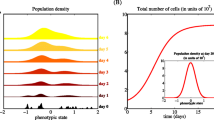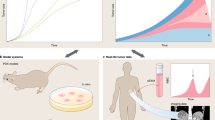Abstract
Predictive modeling of the evolutionary dynamics of cancer is a challenging issue in computational cancer biology. In this paper, we propose a general mathematical model framework for the evolutionary dynamics of cancer, including plasticity and heterogeneity in cancer cells. Cancer is a group of diseases involving abnormal cell growth, during which abnormal regulation of stem cell regeneration is essential for the dynamics of cancer development. In general, the dynamics of stem cell regeneration can be simplified as a G0 phase cell cycle model, which leads to a delay differentiation equation. When cell heterogeneity and plasticity are considered, we establish a differential-integral equation based on the random transition of epigenetic states of stem cells during cell division. The proposed model highlights cell heterogeneity and plasticity; connects the heterogeneity with cell-to-cell variance in cellular behaviors (for example, proliferation, apoptosis, and differentiation/senescence); and can be extended to include gene mutation-induced tumor development. Hybrid computational models are developed based on the mathematical model framework and are applied to the processes of inflammation-induced tumorigenesis and tumor relapse after chimeric antigen receptor (CAR)-T cell therapy. Finally, we propose several mathematical problems related to the proposed differential-integral equation. Solutions to these problems are crucial for understanding the evolutionary dynamics of cancer.
Similar content being viewed by others
References
Bernard S, Bélair J, Mackey M C. Oscillations in cyclical neutropenia: New evidence based on mathematical modeling. J Theoret Biol, 2003, 223: 283–298
Burns F J, Tannock I F. On the existence of a Go-phase in the cell cycle. Cell Tissue Kinet, 1970, 3: 321–334
Chamseddine I M, Rejniak K A. Hybrid modeling frameworks of tumor development and treatment. WIREs Syst Biol Med, 2020, 12: e1461
Chang H H, Hemberg M, Barahona M, et al. Transcriptome-wide noise controls lineage choice in mammalian progenitor cells. Nature, 2008, 453: 544–547
Clevers H. At the crossroads of inflammation and cancer. Cell, 2004, 118: 671–674
de Martel C, Ferlay J, Franceschi S, et al. Global burden of cancers attributable to infections in 2008: A review and synthetic analysis. Lancet Oncol, 2012, 13: 607–615
Dingli D, Traulsen A, Pacheco J M. Stochastic dynamics of hematopoietic tumor stem cells. Cell Cycle, 2007, 6: 461–466
Dykstra B, Kent D, Bowie M, et al. Long-term propagation of distinct hematopoietic differentiation programs in vivo. Stem Cell, 2007, 1: 218–229
Elinav E, Nowarski R, Thaiss C A, et al. Inflammation-induced cancer: Crosstalk between tumours, immune cells and microorganisms. Nat Rev Cancer, 2013, 13: 759–771
Gibson T M, Gersbach C A. Single-molecule analysis of myocyte differentiation reveals bimodal lineage commitment. Integr Biol (Camb), 2015, 7: 663–671
Graf T. Differentiation plasticity of hematopoietic cells. Blood, 2002, 99: 3089–3101
Grivennikov S I, Greten F R, Karin M. Immunity, inflammation, and cancer. Cell, 2010, 140: 883–899
Guo Y C, Nie Q, MacLean A L, et al. Multiscale modeling of inflammation-induced tumorigenesis reveals competing oncogenic and onco-protective roles for inflammation. Cancer Res, 2017, 77: 6429–6441
Hanahan D, Weinberg R A. The hallmarks of cancer. Cell, 2000, 100: 57–70
Hanselmann R G, Welter C. Origin of cancer: An information, energy, and matter disease. Front Cell Dev Biol, 2016, 4: 121
Hayashi K, de Sousa Lopes S M C, Tang F C, et al. Dynamic equilibrium and heterogeneity of mouse pluripotent stem cells with distinct functional and epigenetic states. Stem Cell, 2008, 3: 391–401
Hu G M, Lee C Y, Chen Y-Y, et al. Mathematical model of heterogeneous cancer growth with an autocrine signalling pathway. Cell Prolif, 2012, 45: 445–455
Huang R S, Lei J Z. Dynamics of gene expression with positive feedback to histone modifications at bivalent domains. Internat J Modern Phys B, 2017, 4: 1850075
Huang R S, Lei J Z. Cell-type switches induced by stochastic histone modification inheritance. Discrete Contin Dyn Syst Ser B, 2019, 22: 1–19
Lander A D, Gokoffski K K, Wan F Y M, et al. Cell lineages and the logic of proliferative control. PLoS Biol, 2009, 7: e15
Le Magnen C, Shen M M, Abate-Shen C. Lineage plasticity in cancer progression and treatment. Annu Rev Cancer Biol, 2018, 2: 271–289
Lei J Z. A general mathematical framework for understanding the behavior of heterogeneous stem cell regeneration. BioRxiv, 2019, https://doi.org/10.1101/592139
Lei J Z, Levin S A, Nie Q. Mathematical model of adult stem cell regeneration with cross-talk between genetic and epigenetic regulation. Proc Natl Acad Sci USA, 2014, 111: E880–E887
Lei J Z, Mackey M C. Multistability in an age-structured model of hematopoiesis: Cyclical neutropenia. J Theoret Biol, 2011, 270: 143–153
Mackey M C. Unified hypothesis for the origin of aplastic anemia and periodic hematopoiesis. Blood, 1978, 51: 941–956
Mackey M C. Cell kinetic status of haematopoietic stem cells. Cell Prolif, 2001, 34: 71–83
Malta T M, Sokolov A, Gentles A J, et al. Machine learning identifies stemness features associated with oncogenic dedifferentiation. Cell, 2018, 173: 338–354
Mangel M, Bonsall M B. Phenotypic evolutionary models in stem cell biology: Replacement, quiescence, and variability. PLoS One, 2008, 3: e1591
Mangel M, Bonsall M B. Stem cell biology is population biology: Differentiation of hematopoietic multipotent progenitors to common lymphoid and myeloid progenitors. Theor Biol Med Model, 2013, 10: 5
Parkin D M. The global health burden of infection-associated cancers in the year 2002. Int J Cancer, 2006, 118: 3030–3044
Probst A V, Dunleavy E, Almouzni G. Epigenetic inheritance during the cell cycle. Nat Rev Mol Cell Biol, 2009, 10: 192–206
Puram S V, Tirosh I, Parikh A S, et al. Single-cell transcriptomic analysis of primary and metastatic tumor ecosystems in head and neck cancer. Cell, 2017, 171: 1611–1624
Rockne R C, Hawkins-Daarud A, Swanson K R, et al. The 2019 mathematical oncology roadmap. Phys Biol, 2019, 16: 041005
Rodriguez-Brenes I A, Komarova N L, Wodarz D. Evolutionary dynamics of feedback escape and the development of stem-cell-driven cancers. Proc Natl Acad Sci USA, 2011, 108: 18983–18988
Schepeler T, Page M E, Jensen K B. Heterogeneity and plasticity of epidermal stem cells. Development, 2014, 141: 2559–2567
Serra-Cardona A, Zhang Z G. Replication-coupled nucleosome assembly in the passage of epigenetic information and cell identity. Trends Biochem Sci, 2018, 43: 136–148
Singer Z S, Yong J, Tischler J, et al. Dynamic heterogeneity and DNA methylation in embryonic stem cells. Mol Cell, 2014, 55: 319–331
Situ Q J, Lei J Z. A mathematical model of stem cell regeneration with epigenetic state transitions. Mol Biol Evol, 2017, 14: 1379–1397
Song Y, Yang S Y, Lei J Z. ParaCells: A GPU architecture for cell-centered models in computational biology. IEEE/ACM Trans Comput Biol Bioinf, 2018, 16: 994–1006
Su Y P, Wei W, Robert L, et al. Single-cell analysis resolves the cell state transition and signaling dynamics associated with melanoma drug-induced resistance. Proc Natl Acad Sci USA, 2017, 114: 13679–13684
Takaoka K, Hamada H. Origin of cellular asymmetries in the pre-implantation mouse embryo: A hypothesis. Philos Trans R Soc Lond B Biol Sci, 2014, 369: 20130536
Tarabichi M, Antoniou A, Saiselet M, et al. Systems biology of cancer: Entropy, disorder, and selection-driven evolution to independence, invasion and “swarm intelligence”. Cancer Metastasis Rev, 2013, 32: 403–421
Traulsen A, Lenaerts T, Pacheco J M, et al. On the dynamics of neutral mutations in a mathematical model for a homogeneous stem cell population. J R Soc Interface, 2012, 10: 20120810
Wu H, Zhang Y. Reversing DNA methylation: Mechanisms, genomics, and biological functions. Cell, 2014, 156: 45–68
Zernicka-Goetz M, Morris S A, Bruce A W. Making a firm decision: Multifaceted regulation of cell fate in the early mouse embryo. Nat Rev Genet, 2009, 10: 467–477
Zhou D, Wu D M, Li Z, et al. Population dynamics of cancer cells with cell state conversions. Quant Biol, 2013, 1: 201–208
Acknowledgements
This research was supported by National Natural Science Foundation of China (Grant Nos. 91730101 and 11831015).
Author information
Authors and Affiliations
Corresponding author
Rights and permissions
About this article
Cite this article
Lei, J. Evolutionary dynamics of cancer: From epigenetic regulation to cell population dynamics—mathematical model framework, applications, and open problems. Sci. China Math. 63, 411–424 (2020). https://doi.org/10.1007/s11425-019-1629-7
Received:
Accepted:
Published:
Issue Date:
DOI: https://doi.org/10.1007/s11425-019-1629-7
Keywords
- stem cell regeneration
- differential-integral equation
- cancer development
- computational cancer biology
- open problems




